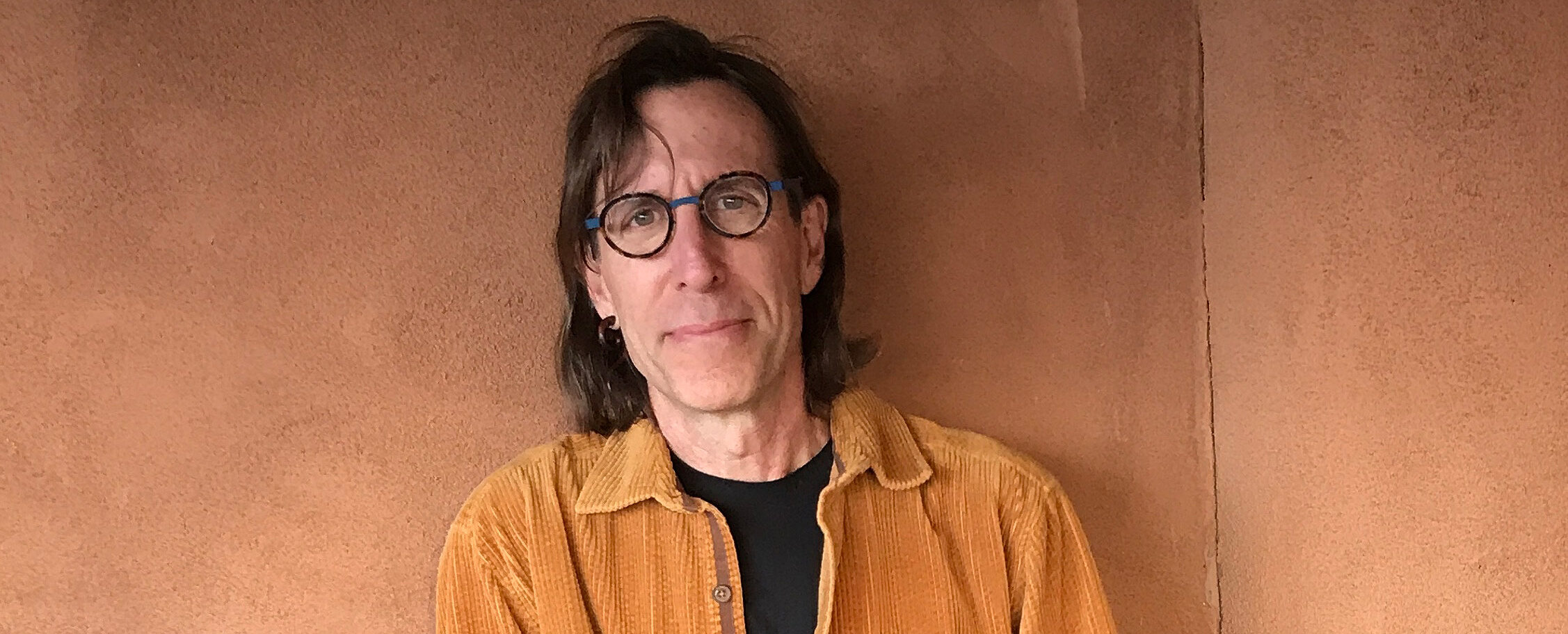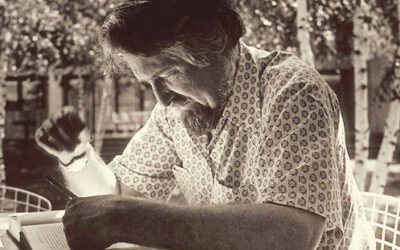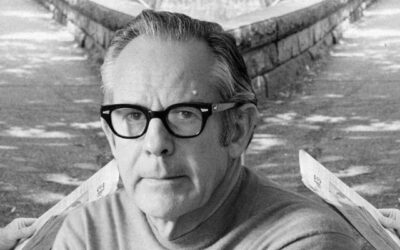
Who is David Abram?
“For the first time in history, the human species has seen fit to wander into the realm of the gods, and we have no clue what we are doing here.”
David Abram (1957-) is a groundbreaking American ecologist, philosopher, and cultural theorist whose work has pioneered a new understanding of the reciprocal relationship between humans and the natural world. Drawing upon his studies of indigenous cultures, his immersion in the natural world, and his creative engagement with the Western philosophical tradition, Abram has articulated a powerful vision of an ecological civilization grounded in a lived experience of the Earth’s sentience and sacred mystery.
Over the course of his influential career, Abram has called for a fundamental restructuring of human perception, language, and identity in alignment with the intelligence of the more-than-human world. His books, including The Spell of the Sensuous (1996) and Becoming Animal (2010), have had a profound impact on the fields of environmental philosophy, ecocriticism, and nature writing, while also inspiring a new generation of activists and visionaries working to heal the rift between humans and the living Earth.
This essay provides an in-depth exploration of Abram’s thought and its significance for navigating the ecological crisis of the 21st century. It elucidates his key ideas regarding the participatory nature of perception, the agency of language, and the need for a renewed attentiveness to the animate Earth. Additionally, it examines his creative appropriation of phenomenology and indigenous wisdom, evaluating his contributions to the emerging fields of ecophenomenology and posthumanist theory. Finally, it offers a retrospective on Abram’s intellectual legacy, assessing which of his proposals have proved most generative while noting critiques of his approach.
Main Ideas and Key Themes:
Abram argues that the ecological crisis is, at its root, a crisis of perception. Modern humans have become estranged from the sensuous, animate Earth, seeing it as a collection of inert objects rather than an expressive, intelligent presence.
He traces this perceptual disconnection to the rise of alphabetic literacy, which he argues shifted human attention away from the direct, participatory experience of the sensuous world and into a more abstract, symbolic mode of cognition.
Drawing on the phenomenology of Maurice Merleau-Ponty and the Ecopsychology of Theodore Roszak, Abram develops a philosophy of “embodied perception.” He argues that all sensing is a form of reciprocal encounter, an interplay between the perceiving body and the expressive presences of the sensuous world.
Abram suggests that the task of an ecological culture is to cultivate forms of perception, language, and practice that affirm the animacy of the Earth and our kinship with the more-than-human world. He calls for a renewed attentiveness to the gestural, expressive qualities of the living land.
Engaging with the work of indigenous philosophers and storytellers, Abram argues that oral, place-based cultures typically experience the natural world as alive and communicative. He suggests that Western culture must recover this animistic sensibility to restore a reciprocal, ethical relationship with the Earth.
Abram proposes that poetic, richly sensuous language can help to resacralize the natural world and renew our felt experience of its mystery and beauty. He experiments with ecopoetic writing as a way of attuning the modern mind to the voice of the land.
He argues that the global ecological crisis calls for a transformation of human identity, from a sense of separateness and superiority to an experience of deep interdependence and kinship with the community of life. An ecocentric sense of self is key to an ethics of care and responsibility for the Earth.
While affirming the Western tradition of phenomenology, Abram also moves beyond it by engaging with animistic and indigenous worldviews. He seeks to develop a cross-cultural “ecology of magic” that recognizes the world as a field of communicative presences.
The Spell of the Sensuous:
The heart of Abram’s work is his exploration of the “spell” of the sensuous world, the way in which the living landscape entrances and entangles us in a field of reciprocal perception and communication. In his landmark book The Spell of the Sensuous, Abram draws upon phenomenology, anthropology, and cognitive science to argue for a fundamental shift in how we understand and experience the natural world.
For Abram, the defining feature of the modern worldview is its disenchantment of the Earth, its reduction of the sensuous world to a collection of inanimate objects. He traces this perceptual impoverishment to the rise of alphabetic literacy and the growing dominance of abstract, linear modes of thought. As written language became the primary medium of cultural meaning, Abram suggests, humans increasingly lost touch with the direct, participatory experience of the animate Earth.
In place of this distanced, objectifying stance, Abram proposes an understanding of perception as a deeply reciprocal, improvisational dance between the sensing body and the expressive presences of the sensuous world. Drawing on the phenomenology of Merleau-Ponty, he argues that all sensing is a form of active engagement, a creative interplay between the perceiver and the perceived. We do not passively register an inert, external world, but rather participate in the world’s self-disclosure through our embodied, attentive presence.
Abram suggests that this participatory understanding of perception was the norm for most oral, place-based cultures throughout human history. He draws upon his studies of indigenous cultures to show how animistic worldviews experience the natural world as alive, intelligent, and communicative. For hunter-gatherers and other traditional peoples, the land is not a passive backdrop but an intimate, sacred presence with its own agency and intentionality.
The task of an ecological culture, for Abram, is to cultivate ways of speaking, thinking, and perceiving that affirm the animacy of the sensuous world and our kinship with the more-than-human community of life. This involves a fundamental restructuring of language, so that it becomes not just a vehicle for abstract concepts but a sensuous, bodily medium that participates in the expressive life of the land.
Abram experiments with poetic, richly descriptive writing as a way of attuning the modern mind to the voice of the animate Earth. By engaging in close, sensory-rich observation of natural phenomena, he seeks to renew our felt experience of the world’s beauty, mystery, and sacredness. His luminous, evocative prose enacts a kind of incantatory spell, inviting the reader into a direct, embodied encounter with the living land.
At the same time, Abram emphasizes that this renewed attentiveness to the sensuous world is not just an aesthetic or spiritual practice, but an urgent ecological and political necessity. By recovering our felt experience of the Earth’s animacy, we open ourselves to a transformed sense of kinship and responsibility for the more-than-human world. An ecocentric identity and ethics naturally flows from a lived experience of our interdependence with the web of life.
Ultimately, for Abram, the “spell of the sensuous” is not just a matter of individual perception but a collective, cultural task. By midwifing a new story of the human as a part of the living Earth, rooted in a sensuous, reciprocal relationship with the more-than-human world, we can begin to heal the wounds of modernity and work towards an ecological civilization. This will require a creative engagement with the wisdom of indigenous cultures, a poetic re-enchantment of language, and a courageous restructuring of our social and political systems. Only by realigning our ways of seeing, speaking, and imagining with the animate Earth, Abram suggests, can we hope to navigate the planetary crisis and create a flourishing future for all beings.
Becoming Animal:
In his later work, particularly his book Becoming Animal, Abram deepens and extends his exploration of the ecological dimensions of perception and identity. He argues that the global ecological crisis calls for a fundamental transformation of the modern sense of self, from an anthropocentric experience of separateness and superiority to an ecocentric understanding of deep interdependence and kinship with the more-than-human world.
For Abram, the root of the ecological crisis lies in the “civilized” conception of the human as a sovereign, rational subject set apart from the irrational, mechanistic world of nature. This dualistic worldview, he suggests, is the product of a long historical process of alienation from the sensuous Earth, exacerbated by the rise of industrial capitalism and consumerist culture. By seeing ourselves as the sole locus of agency and intelligence in a passive, meaningless universe, we have granted ourselves license to exploit and despoil the living land.
In contrast, Abram proposes a vision of the human as a part of the “more-than-human” community of life, an expression of the Earth’s own creativity and sentience. Drawing upon indigenous animistic philosophies, he suggests that all things – from rivers and mountains to birds and insects – are animate, communicative presences with their own agency and intentionality. The human is not a separate, superior being but an ecological self, deeply interwoven with the fabric of the living world.
Abram explores how cultivating this ecocentric sense of identity involves a process of “becoming animal,” of attuning our sensing bodies to the rhythms, patterns, and presences of the more-than-human world. By paying close attention to the gestural, expressive qualities of natural phenomena – the way a raven rides the currents of the wind, or a spider spins its intricate web – we can begin to experience the world as a field of communicative, sentient presences.
This attentiveness to the more-than-human world, Abram suggests, is not just a matter of perception but of active participation. By engaging in embodied, sensory practices like tracking, foraging, and dreamwork, we can cultivate a felt sense of kinship and reciprocity with the living land. These practices, he argues, are not just recreational pursuits but vital ways of knowing, of aligning our awareness with the intelligence of the Earth.
Abram also extends his critique of alphabetic literacy in Becoming Animal, arguing that the written word has played a key role in severing our sensuous, reciprocal bond with the more-than-human world. He suggests that the rise of the printing press and the spread of mass literacy further entrenched a disembodied, abstract mode of cognition that sees the world as a collection of inert objects rather than a community of subjects.
In response, Abram calls for a renewed orality, a way of speaking and thinking that is rooted in the sensuous, participatory life of the body. He experiments with poetic, animistic language as a way of restorying the modern sense of self and world. By infusing his prose with the sounds, rhythms, and metaphors of the more-than-human world, he seeks to enact a “magic” of language, a spellbinding attunement to the Earth’s own expressiveness.
Ultimately, for Abram, “becoming animal” is about more than just personal transformation; it is an ecological and political imperative. By recovering our felt sense of kinship with the more-than-human world, we lay the groundwork for a new ethic of reciprocity and responsibility, a way of living that honors the intrinsic value and agency of all beings. This, he suggests, is the key to building an ecological civilization that can sustain the diversity and flourishing of life on Earth.
At the heart of this vision is a fundamental re-enchantment of the world, a recovery of the animistic understanding of the Earth as a sacred, sentient presence. By learning to perceive the natural world as a field of communicative subjects rather than a collection of objects, we open ourselves to a renewed sense of wonder, humility, and reverence for the mystery of being. This re-enchantment, Abram argues, is not a regression to pre-modern superstition but a necessary evolution of human consciousness, one that integrates the insights of science with the wisdom of indigenous ways of knowing.
Abram’s “Ecology of Magic” and Indigenous Thought:
One of the most distinctive and generative aspects of Abram’s work is his creative engagement with indigenous philosophies and practices. Throughout his writing, he draws upon his experiences with traditional cultures from around the world to challenge Western assumptions about the nature of reality and to articulate an alternative, animistic understanding of the Earth as a living, sacred presence.
In both The Spell of the Sensuous and Becoming Animal, Abram recounts his formative encounters with indigenous shamans and storytellers, whose ways of speaking and perceiving revealed to him a radically different experience of the more-than-human world. For these traditional cultures, he suggests, the natural world is not a collection of inert objects but a dynamic, communicative presence with its own agency and intentionality.
Abram is particularly influenced by the animistic worldviews of indigenous North American cultures, such as the Navajo, Hopi, and Apache. He explores how these cultures understand the land as a sacred, living being, suffused with spiritual power and intelligence. For the Navajo, for instance, the landscape is alive with holy people, ancestral presences, and animal spirits who communicate with humans through signs, dreams, and ceremonies.
Drawing on these indigenous philosophies, Abram develops the concept of an “ecology of magic,” a participatory way of experiencing the world as a field of animate, expressive presences. He suggests that for most oral, place-based cultures, the practice of magic is not a matter of supernatural control but of attunement to the living landscape, of reading and responding to the signs and gestures of the more-than-human world.
Abram argues that this magical, animistic sensibility is not a primitive superstition but a sophisticated way of knowing, one that is grounded in a deep, embodied attentiveness to the natural world. By cultivating practices of tracking, divination, and dreamwork, indigenous cultures have developed a profound ecological intelligence, a capacity to read the subtle patterns and energies of the living land.
Moreover, Abram suggests that this animistic way of experiencing the world is not unique to indigenous cultures but is a potentiality of human consciousness itself. He argues that all humans, at a preconceptual level, encounter the world as a field of animate, expressive presences. It is only through the overlay of cultural conditioning, particularly the abstracting tendencies of alphabetic literacy, that we come to see the world as a collection of inanimate objects.
Abram’s engagement with indigenous thought is not a naive romanticization or appropriation but a serious attempt to challenge the limitations of Western epistemology and to articulate an alternative, ecocentric way of knowing. He is careful to acknowledge the cultural specificity of indigenous practices and to avoid universalizing or decontextualizing them.
At the same time, Abram suggests that the ecological crisis calls for a creative cross-pollination between Western and indigenous ways of knowing. He argues that the insights of phenomenology and ecology can be enriched and transformed through dialogue with animistic philosophies, while indigenous cultures can benefit from engaging with Western scientific knowledge and critical theory.
Ultimately, for Abram, the “ecology of magic” is not just an anthropological curiosity but an urgent necessity for navigating the planetary crisis. By recovering our capacity to experience the world as a sacred, communicative presence, we open ourselves to a transformed sense of kinship and responsibility for the more-than-human community of life. This, he suggests, is the key to healing the modern rift between humans and nature and to building an ecological civilization that can sustain the flourishing of the Earth.
Unique Threads in Merleau-Ponty and Abram’s Development of Them:
Another key aspect of Abram’s work is his creative appropriation and extension of the phenomenology of Maurice Merleau-Ponty. While Abram draws upon a range of philosophical traditions, including pragmatism, animism, and poststructuralism, his thought is most deeply rooted in Merleau-Ponty’s exploration of embodied perception and the intertwining of self and world.
In his landmark work Phenomenology of Perception, Merleau-Ponty challenged the Cartesian dualism of mind and body, arguing that consciousness is not a disembodied cogito but a bodily, sensory engagement with the world. For Merleau-Ponty, perception is not a passive reception of sense data but an active, creative process in which the body and the world are co-constituting.
Abram picks up on this insight and develops it in an ecological direction. He suggests that Merleau-Ponty’s understanding of perception as a reciprocal, participatory process can be extended to include not just the human body but the more-than-human world as well. Just as there is a “reversibility” between the sensing body and the sensible world, Abram argues, there is a reciprocity between the human and the animate Earth.
In The Spell of the Sensuous, Abram develops this idea through the concept of the “flesh of the world,” which he adapts from Merleau-Ponty. For Abram, the “flesh” is not just the physical stuff of the body but the elemental medium that connects all beings. It is the “intertwining” of self and world, the reciprocal participation of the perceiver and the perceived.
Abram suggests that this understanding of the “flesh” as a shared, animate medium challenges the modern conception of the self as a bounded, autonomous subject. Instead, it reveals the self to be an ecological being, a node in a web of relationships that includes not just other humans but the more-than-human world as well.
Moreover, Abram argues that this ecological understanding of selfhood has ethical and political implications. By recognizing our participation in the “flesh of the world,” we come to see the natural world not as a collection of resources to be exploited but as a community of subjects to be respected and cared for. An ecocentric ethic of reciprocity and responsibility naturally flows from an embodied, participatory experience of the world.
Another key idea that Abram draws from Merleau-Ponty is the notion of “wild being,” which he develops in his later work. For Merleau-Ponty, “wild being” refers to the prereflective, spontaneous dimension of experience that precedes and exceeds our conceptual categories and abstractions. It is the “savage mind” that perceives the world in its raw, undomesticated state, prior to the overlays of language and culture.
Abram extends this notion of “wild being” to the more-than-human world, arguing that the Earth itself has a kind of prereflective, spontaneous intelligence that communicates itself through the gestures and expressions of the sensuous world. He suggests that by cultivating a “wild” mode of perception, one that is attentive to the dynamic, ever-changing patterns of the natural world, we can begin to attune ourselves to the “wild being” of the Earth.
This attunement to the “wild being” of the more-than-human world, Abram suggests, is not just an aesthetic or spiritual practice but an ecological and political necessity. By recovering our sensory, embodied engagement with the animate Earth, we open ourselves to a transformed understanding of our place in the web of life and our responsibility to the larger community of beings.
Abram also draws upon Merleau-Ponty’s later work on language and expression to develop his own understanding of the relationship between language and the more-than-human world. In his essay “The Intertwining-The Chiasm,” Merleau-Ponty suggests that language is not a purely human creation but emerges from the expressive, gestural dimension of bodily experience.
Abram picks up on this idea and suggests that language is rooted in the expressive, communicative power of the more-than-human world itself. He argues that the sounds, rhythms, and metaphors of language are not arbitrary conventions but are deeply influenced by the patterns and presences of the sensuous world.
For Abram, this understanding of language as emergent from the embodied, sensory engagement with the world has profound implications for how we think about the relationship between language and ecology. Rather than seeing language as a purely human construct that separates us from nature, Abram suggests that poetic, richly sensuous language can help to attune us to the voices and gestures of the more-than-human world.
Ultimately, Abram’s engagement with Merleau-Ponty is not just an application of phenomenological ideas to ecological questions but a creative extension and transformation of phenomenology itself. By bringing Merleau-Ponty’s insights into dialogue with animistic and indigenous philosophies, Abram develops a distinctively ecological phenomenology, one that recognizes the active, expressive, and participatory nature of the more-than-human world.
At the same time, Abram’s work also challenges and enriches Merleau-Ponty’s thought in important ways. By extending the notion of “flesh” and “wild being” to the Earth itself, Abram develops a more explicitly ecocentric understanding of phenomenology, one that recognizes the agency and intentionality of the more-than-human world. And by exploring the ecological dimensions of language and expression, he opens up new possibilities for thinking about the relationship between culture and nature, humans and the Earth.
Abram’s Methodology and Writing Style:
A distinctive feature of David Abram’s work is his unique methodology and writing style, which blend rigorous scholarship with poetic, evocative prose. Unlike many academic writers who prioritize a detached, analytical voice, Abram adopts a more embodied, experiential approach that seeks to enact and awaken the participatory nature of perception.
At the heart of Abram’s methodology is a commitment to phenomenology, the philosophical study of direct, lived experience. Rather than starting with abstract concepts or theories, Abram begins with a close, sensory attentiveness to the phenomena of the natural world. He immerses himself in the textures, rhythms, and presences of particular landscapes, using his body as an instrument of knowing.
This embodied, sensory approach is evident in Abram’s lush, poetic writing style, which seeks to evoke the felt experience of being embedded in a sensuous, animate Earth. His prose is thick with vivid descriptions of natural phenomena, from the swoop of a raven’s flight to the burble of a mountain stream. He often writes in the first person, recounting his own encounters with the more-than-human world as a way of inviting the reader into a direct, participatory experience.
At the same time, Abram’s writing is deeply informed by his engagement with a wide range of scholarly disciplines, including anthropology, cognitive science, and philosophy. He draws upon his fieldwork with indigenous cultures to challenge Western assumptions about the nature of reality and to articulate alternative ways of knowing and being in the world.
Abram’s methodology is also deeply dialogical and collaborative. Rather than presenting his ideas as a finished product, he sees them as part of an ongoing conversation with other thinkers, activists, and practitioners. He often engages in public dialogues and workshops, using storytelling, poetry, and experiential exercises to invite others into a deeper attunement with the animate Earth.
This dialogical approach is evident in Abram’s writing, which often takes the form of a philosophical conversation or journey. Rather than presenting a linear argument, he often circles around a theme or question, approaching it from multiple angles and inviting the reader to participate in the unfolding exploration.
Central to Abram’s methodology is a rejection of the modern separation between objective and subjective ways of knowing. He argues that the ecological crisis demands a more integrated, participatory approach that recognizes the interpenetration of the observer and the observed. This requires a willingness to surrender the stance of the detached, neutral researcher and to embrace a more engaged, embodied way of knowing.
Abram’s writing enacts this participatory approach through its use of sensuous, animated language and its invitation to the reader to enter into a direct, felt relationship with the more-than-human world. By dissolving the boundary between self and world, his prose seeks to awaken a sense of wonder, kinship, and responsibility for the living Earth.
Ultimately, for Abram, the act of writing is not just a means of communicating ideas but a way of aligning human language and imagination with the expressive, poetic power of the Earth itself. By infusing his prose with the rhythms, metaphors, and sensuous presences of the more-than-human world, he seeks to enact a kind of “ecopoetics,” a language that participates in the creativity and intelligence of the animate Earth.
This ecopoetic approach has had a profound influence on the fields of nature writing, ecocriticism, and environmental philosophy. Abram’s writing has inspired a new generation of writers and artists to explore the eco-phenomenological dimensions of language and storytelling, and to develop new forms of expression that honor the voice and agency of the more-than-human world.
At the same time, Abram’s methodology has also been criticized by some scholars for its lack of critical distance and its tendency toward romanticization. Some have argued that his poetic, experiential approach risks overlooking the cultural and historical specificities of different ways of knowing and being in the world.
Others have suggested that Abram’s emphasis on individual, sensory experience can obscure the broader social and political dimensions of the ecological crisis, and the need for collective action and systemic change.
Despite these critiques, Abram’s work remains a powerful and transformative force in the field of eco-philosophy. His unique blend of poetic sensibility, scholarly rigor, and activist passion has opened up new possibilities for rethinking the relationship between humans and the more-than-human world, and for imagining a more ecologically attuned and resonant way of being.
As the global ecological crisis deepens, Abram’s call for a re-enchantment of the sensuous world and a renewed attentiveness to the animate Earth becomes ever more urgent and necessary. His work encourages us to cultivate a more embodied, participatory way of knowing, one that recognizes the reciprocity and kinship between self and world, culture and nature, language and land.
By attuning ourselves to the expressive, poetic dimensions of the more-than-human world, Abram suggests, we can begin to heal the modern rift between humans and the Earth, and to participate more fully in the interconnected web of life. This requires a willingness to surrender our illusions of separation and control, and to embrace a more humble, listening stance in the face of the Earth’s wild otherness.
Ultimately, for Abram, the work of eco-philosophy is not just an intellectual exercise but a deeply personal and political practice, one that demands a transformation of our ways of speaking, thinking, and imagining. By aligning our language and perception with the animate Earth, we can begin to chart a new course for human culture, one that honors the creativity and resilience of the more-than-human world and that works towards a more just and sustainable future for all beings.
Criticism and Retrospective:
While David Abram’s work has been widely celebrated for its originality, poetic power, and ethical force, it has also been the subject of significant criticism and debate. Some scholars have questioned the philosophical rigor of his arguments, while others have raised concerns about the political implications of his emphasis on individual experience and the romanticization of indigenous cultures.
One common critique of Abram’s work is that it relies too heavily on poetic and metaphorical language at the expense of clear, logical argumentation. Some philosophers have argued that his use of sensuous, evocative prose can obscure the precise nature of his claims and make it difficult to assess their validity.
Others have suggested that Abram’s emphasis on the primacy of direct, sensory experience risks downplaying the importance of abstract reasoning and conceptual analysis. They argue that while embodied experience is certainly important, it cannot be the sole basis for philosophical reflection and must be complemented by more discursive and argumentative modes of inquiry.
Another line of criticism focuses on the political implications of Abram’s work. Some scholars have argued that his emphasis on individual, sensory attunement to the natural world can lead to a kind of apolitical quietism, a retreat from the hard work of collective struggle and systemic change. They suggest that while a renewed sense of kinship with the more-than-human world is certainly necessary, it is not sufficient to address the root causes of ecological destruction, which are deeply entangled with systems of social and economic power.
Related to this, some critics have raised concerns about Abram’s tendency to romanticize indigenous cultures and their ways of knowing. While his engagement with animistic and shamanic practices has certainly been generative and illuminating, some scholars worry that it risks perpetuating a kind of “noble savage” stereotype that ignores the complexity and diversity of indigenous societies.
They argue that Abram’s portrayal of indigenous peoples as inherently ecological and spiritually attuned can obscure the historical and political realities of colonialism, dispossession, and cultural change. It can also lead to a kind of appropriation or instrumentalization of indigenous knowledge, rather than a genuine dialogue and collaboration.
Despite these criticisms, however, Abram’s work remains a vital and transformative force in the field of eco-philosophy. His unique blend of phenomenology, animism, and ecological thought has opened up new ways of thinking about the relationship between humans and the more-than-human world, and has inspired a generation of scholars, activists, and practitioners to cultivate a more embodied and engaged way of being.
In particular, Abram’s emphasis on the reciprocity and interwwowenness of self and world has been enormously generative for the development of ecofeminism, posthumanism, and new materialist thought. His understanding of the “flesh of the world” as a shared, animate medium has helped to challenge the anthropocentric assumptions of Western philosophy and to articulate a more respectful and responsible relationship with alterity more generally.
Moreover, Abram’s work has had a profound impact on the field of nature writing and environmental literature. His poetic, evocative prose has inspired a new generation of writers to explore the eco-phenomenological dimensions of language and storytelling, and to develop new forms of expression that honor the voice and agency of the more-than-human world.
At the same time, Abram’s emphasis on the importance of sensory, embodied experience has helped to counter the disembodied and abstract tendencies of much academic discourse. By grounding his philosophical reflections in the concrete, material realities of particular places and landscapes, he has modeled a more situated and engaged way of knowing that has resonance far beyond the confines of the academy.
As we grapple with the existential challenges of the Anthropocene, Abram’s call for a renewed attentiveness to the animate Earth and a re-enchantment of the sensuous world feels more urgent and necessary than ever. While his work certainly has its limitations and blind spots, it remains a vital resource for anyone seeking to cultivate a more reciprocal, responsible, and resilient relationship with the more-than-human world.
Ultimately, the enduring significance of Abram’s work may lie less in the specifics of his arguments than in the broader ethos and sensibility that he embodies. His writing invites us to cultivate a more gracious, humble, and listening stance in the face of the Earth’s astonishing complexity and otherness. It challenges us to expand our circle of concern and compassion beyond the human realm, and to recognize our profound interdependence with the web of life.
By attuning ourselves to the wild, expressive power of the more-than-human world, Abram suggests, we can begin to heal the wounds of modernity and to participate more fully in the Earth’s own process of creative unfolding. This is not a matter of returning to some idealized past or abandoning the insights of science and reason, but of forging a new way forward that honors the wisdom of indigenous and ecological ways of knowing.
As we navigate the stormy waters of the 21st century, Abram’s vision of a re-enchanted Earth and a renewed human relationship with the more-than-human world will undoubtedly continue to inspire and provoke. While his work is certainly not the last word on these matters, it remains an essential starting point for anyone seeking to imagine a more sane, sustainable, and equitable future.
Timeline of David Abram’s Life:
1957 – Born in New York City, New York, USA.
1980s – Conducted field research among indigenous shamans in Indonesia, Nepal, and the Americas.
1989 – Earned a Ph.D. in Philosophy from the State University of New York, Stony Brook.
1990s – Taught environmental philosophy and ecopsychology at various institutions, including the University of California, Santa Cruz and the California Institute of Integral Studies.
1996 – Published his first book, “The Spell of the Sensuous: Perception and Language in a More-than-Human World,” which became a seminal work in eco-phenomenology and environmental thought.
2010 – Published his second book, “Becoming Animal: An Earthly Cosmology,” which further developed his ideas about animism, embodied perception, and human-animal kinship.
2010s – Continued to teach, lecture, and lead workshops on eco-philosophy, storytelling, and cultural transformation around the world.
2020s – Remains active as a public intellectual, writer, and advocate for ecological renewal and interspecies solidarity.
David Abram Selected Bibliography:
The Spell of the Sensuous: Perception and Language in a More-than-Human World (1996)
Becoming Animal: An Earthly Cosmology (2010)
“The Ecology of Magic: A Personal Introduction to the Inquiry” in Ecopsychology: Restoring the Earth, Healing the Mind (1995)
“The Perceptual Implications of Gaia” in Dharma Gaia: A Harvest of Essays in Buddhism and Ecology (1991)
“Merleau-Ponty and the Voice of the Earth” in Environmental Ethics (1988)
“Depth Ecology” in The Encyclopedia of Religion and Nature (2005)
“Reciprocity” in Rethinking Nature: Essays in Environmental Philosophy (2004)
“Animism and the Alphabet” in The Handbook of Contemporary Animism (2013)
“On Being Human in a More-than-Human World” in Ecopsychology: Science, Totems, and the Technological Species (2012)
“Earth in Eclipse: An Essay on the Philosophy of Science and Ethics” in Scientists Debate Gaia (2004)
References:
Abram, D. (1988). Merleau-Ponty and the voice of the Earth. Environmental Ethics, 10(2), 101-120.
Abram, D. (1991). The perceptual implications of Gaia. In A. H. Badiner (Ed.), Dharma Gaia: A harvest of essays in Buddhism and ecology (pp. 75-92). Berkeley, CA: Parallax Press.
Abram, D. (1995). The ecology of magic: A personal introduction to the inquiry. In T. Roszak, M. E. Gomes, & A. D. Kanner (Eds.), Ecopsychology: Restoring the Earth, healing the mind (pp. 301-315). San Francisco, CA: Sierra Club Books.
Abram, D. (1996). The spell of the sensuous: Perception and language in a more-than-human world. New York, NY: Pantheon Books.
Abram, D. (2004a). Earth in eclipse: An essay on the philosophy of science and ethics. In S. H. Schneider, J. R. Miller, E. Crist, & P. J. Boston (Eds.), Scientists debate Gaia: The next century (pp. 75-92). Cambridge, MA: MIT Press.
Abram, D. (2004b). Reciprocity. In B. V. Foltz & R. Frodeman (Eds.), Rethinking nature: Essays in environmental philosophy (pp. 77-92). Bloomington, IN: Indiana University Press.
Read More Depth Psychology Articles:
Taproot Therapy Collective Podcast
Jungian Innovators
Jungian Topics
How Psychotherapy Lost its Way
Therapy, Mysticism and Spirituality?
The Symbolism of the Bollingen Stone
What Can the Origins of Religion Teach us about Psychology
The Major Influences from Philosophy and Religions on Carl Jung
How to Understand Carl Jung
How to Use Jungian Psychology for Screenwriting and Writing Fiction
The Symbolism of Color in Dreams
How the Shadow Shows up in Dreams
Using Jung to Combat Addiction
Jungian Exercises from Greek Myth
Jungian Shadow Work Meditation
Free Shadow Work Group Exercise
Post Post-Moderninsm and Post Secular Sacred
The Origins and History of Consciousness
Jung’s Empirical Phenomenological Method
The Future of Jungian Thought
Jungian Analysts


























0 Comments